The Google Pixel 4 XL Review: Stuck In The Past In 2019
by Andrei Frumusanu on November 8, 2019 11:30 AM EST- Posted in
- Mobile
- Smartphones
- Pixel 4
- Pixel 4 XL
Display Measurement
The display of the Pixel 4 is one of the phone’s main features thanks to the 90Hz refresh rate. As mentioned in the introduction, the displays on the Pixel 4 series this year is again dual-sourced between LG and Samsung. The regular Pixel 4 receives an LG panel, while the 4 XL that we’re testing and reviewing today, uses a Samsung display.
Android Q promised to have implemented a new iteration of Google’s colour management system, and for the first time, the Photos app is actually able to properly display wide gamut pictures. Unfortunately, it’s still a very limited system in apps as they cannot display differing gamut pictures side-by-side, so for example the thumbnail view is shown only in sRGB. Most importantly, Chrome by default still doesn’t support wide-gamut content as you have to force it in the engine settings, and this implementation doesn’t use the OS’s CMS handling.
We move on to the display calibration and fundamental display measurements of the Pixel 4 XL screen. As always, we thank X-Rite and SpecraCal, as our measurements are performed with an X-Rite i1Pro 2 spectrophotometer, with the exception of black levels which are measured with an i1Display Pro colorimeter. Data is collected and examined using SpectraCal's CalMAN software.

Starting off with the brightness, the Pixel 4 XL is relatively conservative as it peaks out at 438 nits in all scenarios. It’s again very odd here as Google can’t seem to make up its mind on whether it wants to offer an auto-brightness boost or not. Last year, the Pixel 3 only had it available in its Adaptive mode, whilst this year the Pixel 4 doesn’t offer it all, even though the display drivers actually has the high-brightness mode implemented.
In terms of greyscale calibration and accuracy, on my unit things differed greatly based on brightness. At maximum brightness, the Pixel 4 XL was seemingly quite accurate with good colour balance and gamma reproduction. At our standard 200cd/m² measurement point however, things are quite worse. First off, all there’s a more notable colour shift towards greens on the unit which isn’t great. Following that, there’s also creeping issues with the gamma calibration as it’s non-linear and deviates a lot more from the 2.2 target. What this results in is some shades, especially at the higher levels, appear darker than they should be.
I’ve also noted and captured some sort of bug in the display behaviour; when I was measuring at minimum brightness, I encountered some really bad results. I’ve seen this mentioned by some other reviewers and the issue went away when I toggled the screen refresh rate. The odd thing though, is that I wasn’t able to immediately reproduce it afterwards and results on the new measurements were quite ok. The colour shift the phone took was extremely noticeable at the time the bug took place.

SpectraCal CalMAN
"Natural" Greyscale colours

In terms of dE2000, the biggest culprit to the average 2.29 result for me is the green tint of whites as well as the slightly off gamma.
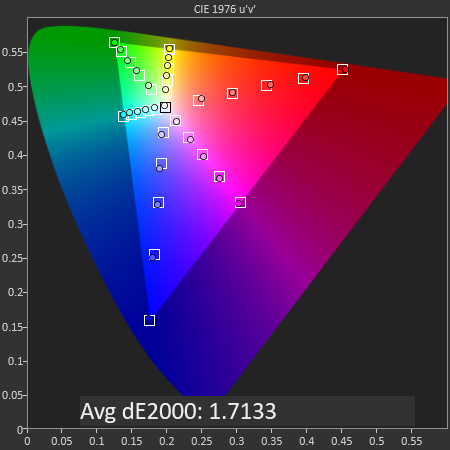
SpectraCal CalMAN
sRGB Gamut
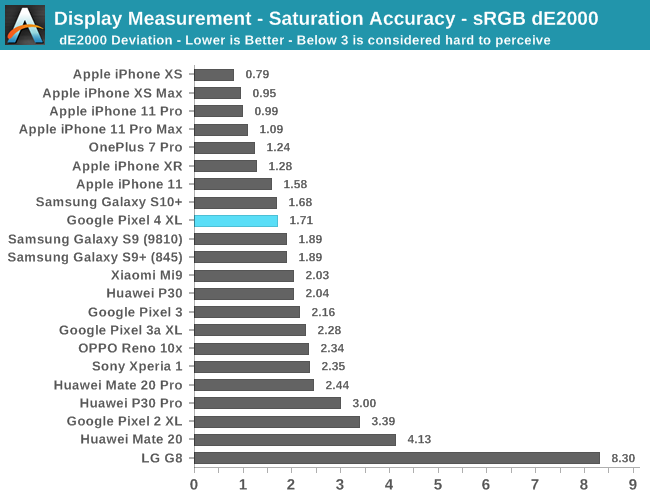
In the sRGB gamut, the Pixel 4 XL does well with a dE2000 of 1.71. The biggest issue again is a shift in the tones towards green, but also seemingly very slight oversaturation of all the tones.
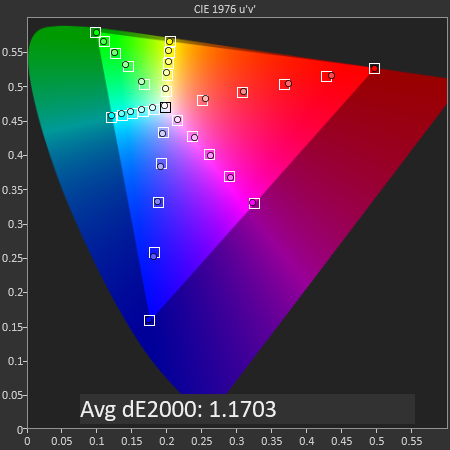
SpectraCal CalMAN
Display P3 Gamut
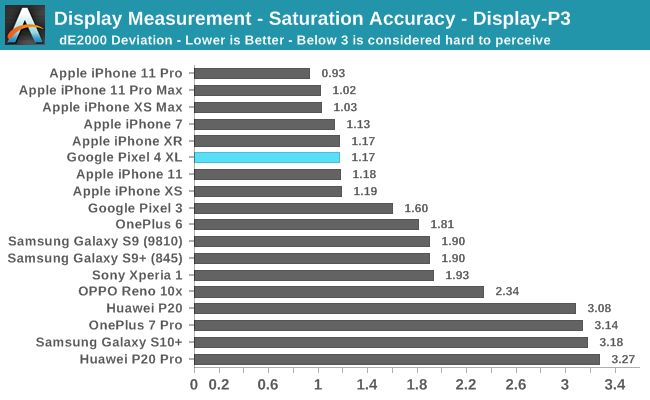
The Display P3 gamut performs a lot better. Here while the green tint is still present, the saturation levels are better and thus the Pixel 4 XL ends up with an excellent dE2000 of 1.17.

SpectraCal CalMAN
Gretag-Macbeth

Finally, in the GMB test, the Pixel 4 XL ends up quite average with a score of 2.34 as it’s showcasing tones that are too dark, a green tint in the whites, with some hue errors for a few tones.
Display Conclusion – Good, but not A+
Overall, the Pixel 4 XL’s display characteristics beyond it’s 90Hz refresh rate are quite average. Whilst Google has been able to improve the calibration compared to what we measured on the regular Pixel 3 last year and the 2 XL the year before that, it’s still quite a bit behind what some other vendors are able to achieve. The display’s lower brightness is also a bit of an issue in direct sunlight as it lacks any kind of boost behaviour. Finally, the remaining characteristics such as viewing angles and sharpness are excellent, but that’s just generally a common characteristic of panels with these specifications.
The results today aren’t really a surprise to me given Google’s track record with the displays on the Pixel series, however it does stand in contrast to what the company was proclaiming at launch: “A+ rating Best Smartphone Display Awards” really doesn’t mean anything at all if, first of all, it’s a sponsored award, and secondly, if the measurements aren’t representative of a random production unit. Make of it what you will.


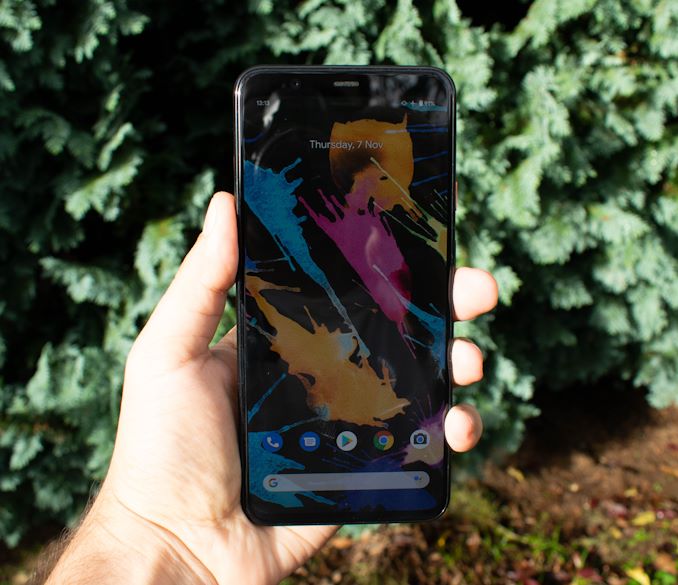
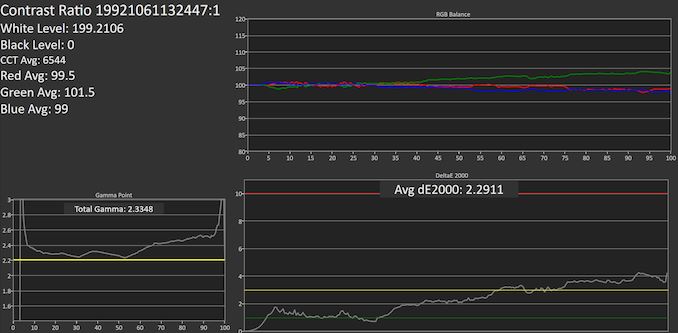
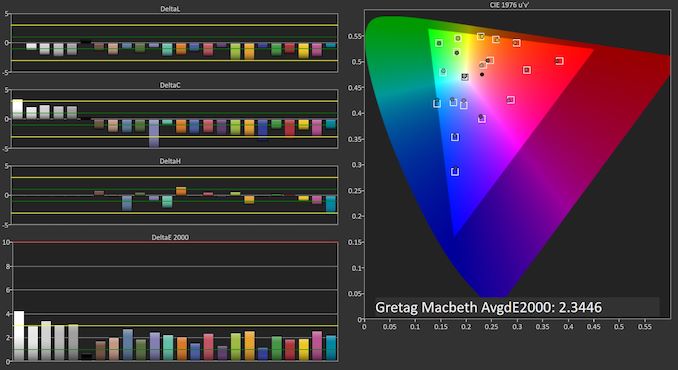








159 Comments
View All Comments
Death666Angel - Sunday, November 10, 2019 - link
Custom ROMs are a thing, do your research before to get a phone that is well supported and you can have unlimited* software support. I can get an Android 9.0 ROM for my Moto G 2013.And if you buy the right phone, something like a Pocophone from last year or a Xiaomi Mi 9 variant now, you can get a top of the line specced phone (S855, 6 GB RAM, 64+ GB ROM, 1080+ AMOLED, 48 MP tripple cameras etc.) for half the price of the entry level iPhone 11, get good custom ROM support and even decent normal support for a year or two and if you don't anymore, you can buy the newest thing from them and have paid less than one iPhone for 2 phones in the end. You can even get their entry level phone with a slower SoC and if you don't game you won't notice the performance difference in Facebook or Youtube, and then get 3 phones for the price of one iPhone.
Spunjji - Monday, November 11, 2019 - link
I'll take 3 years of support on my OnePlus device for roughly 1/2 to 2/3 of what an equivalent-spec iPhone would have cost. The battery's already tired after that length of time, and even if you keep your iPhone a year or two longer I'm still winning on cost.Sharma_Ji - Sunday, November 10, 2019 - link
Well, what?Google only released latest security patches along with updates to all their pixel phones on 5th of nov and does this each month.
It's a rarity that some OEM pushes those before google does, essential only does simultaneously.
And when other's do, they still get 1st of each month .
Sharma_Ji - Sunday, November 10, 2019 - link
Well, what?Google only released latest security patches along with updates to all their pixel phones on 5th of nov and does this each month.
It's a rarity that some OEM pushes those before google does, essential only does simultaneously.
And when other's do, they still get 1st of each month .
phoenix_rizzen - Monday, November 11, 2019 - link
The Galaxy S7 I am typing this with received 2 full OS upgrades, and is running the Aug 1 2019 k installed in Sept). It has received security updates every other month for the past year, so I'm expecting the next one in the next or so.My wife's Galaxy A8 (2018) has already received an OS upgrade and gets security updates every other month as well. We've had it for just over a year now.
Our old Galaxy S6 received OS upgrades, and the last security update it received was for late 2018.
IOW, Samsung update process has greatly improved the past few years. You get 2 full OS upgrades and at least 3 years of security updates.
ahamling27 - Friday, November 8, 2019 - link
Um, OnePlus?flyingpants265 - Saturday, November 9, 2019 - link
For me, the real choices haven't changed much since the beginning. Samsung, LG or Nexus 4/5/HTC Desire/OnePlus. Either the latest flagship, or a decent Google-only device. Not a cheap plastic mid-tier phone (unless that cheap phone is also a Nexus5-type phone with at least flagship CPU.) Pixel 4 should be $400 total.. So should be 50% off.Spunjji - Monday, November 11, 2019 - link
You missed OnePlus in your final assessment. They don't do much to the OS, and I've found the small things they do very useful. They don't do Qi either, but their Dash charge and superior battery life serve the same practical function.I consider them to be an ideal replacement for the Nexus line that Google ditched.
Jonahtrav - Friday, November 8, 2019 - link
Back in May of this year I bought a pixel 3a just to give it a try and I so enjoy the experience I sold my iPhone 8 plus and waited for the pixel 4 to come out and I've been watching reviews and I have to say up kind of disappointed in this phone. Recent review I watched was YouTuber by jerry-rig which tested the durability of the pixel for it failed miserably cracks in 4 areas...yeah I know I know I'm going to stick it in the case but you know it's a back pocket and you sit down in your car forget to take it out take it out after you sit down and madewell cause a problem but after watching that review I don't think I'm buying a mix before going to keep my pixel 3 a.... In the battery was the first thing I thought what a disasterPeachNCream - Friday, November 8, 2019 - link
Underwhelming, but some of the feature decisions can be explained. 64GB base storage encourages people to make more use of cloud alternatives so Alphabet has greater access to perform analytics on user uploaded information. It's hard to pilfer information from over someone's cellular data plan without that catching attention and motivating the IT security types to go poking around at what you're doing. Encouraging users to put information out there of their own free will means analytics will attract a lot less attention.Face unlock is downright alarming stuff that would do Eric Schmidt's decade-old walk right up to the creepy line (his own words back when he was the CEO of Google) expected justice. All that sensor equipment can capture a significant amount of data and put facial analysis of other photographs from other sources into a more useful context. Alphabet is leaning forward here and I would expect the mothership's repository of highly personal data to increase somewhat from this and the addition of Fitbit biometrics collection -- but it's all beneficial to society so it's okay, right?
As for RAM, I don't see a significant disadvantage in only including 6GB. I rarely see utilization go beyond 900MB on my current phone. Maybe being a bit behind on OS versions has something to do with it though. The only problem here is that Google is offering less memory and less storage for a similar price after showing up late to the party.